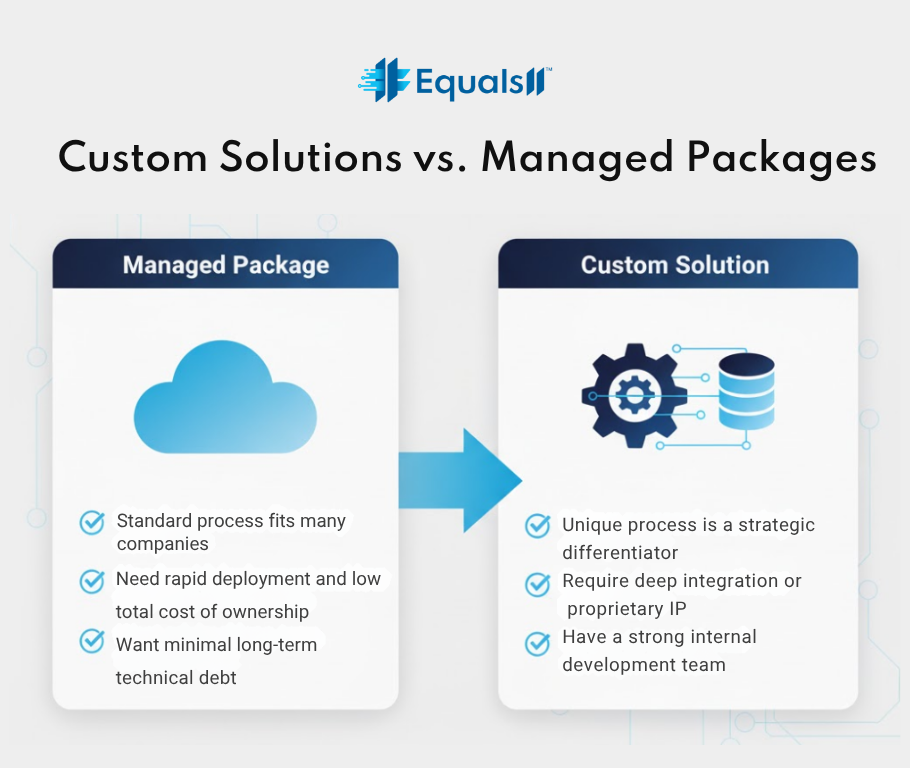Custom Solutions vs. Managed Packages: Which Pays Off in the Long Run for Your Salesforce Org?
Every business using Salesforce eventually arrives at a fork in the road:
Should we build a fully custom solution to mirror our unique process, or rely on a managed package built for scalability and maintainability?
If your IT leader, VP of Marketing, or Salesforce Admin is asking this question, you’re not alone. In fact, the decision you make here has a major impact on the long-term health of your Salesforce org. Technical debt, operational agility, cost of change, resource dependencies, and scalability all depend on it.
In this article, we’ll walk through:
Why a managed package is often the safer bet for avoiding technical debt
When a custom solution still makes sense
How to evaluate each path objectively
A real-world case study from Equals 11
Why Managed Packages Often Win on Long-Term Health
1. Lower Ongoing Support Burden
Managed packages are developed, maintained, and versioned by the vendor. That means your team doesn’t bear the full burden of every upgrade, bug fix, or system update.
In contrast, a custom build means your internal or external development team is responsible for everything. When those resources move on or shift priorities, you inherit risk and lose institutional knowledge.
2. Reduced Risk of Developer Dependency
Custom solutions often create dependencies on individual developers or small teams who originally built them. When those people leave or move to other projects, the knowledge gap begins.
A mature managed package usually comes with documentation, version history, support channels, and a broader user base. That mitigates single points of failure.
3. Scalability and Upgrades Are Built-In
Managed packages are designed to serve many customers, so scalability, change management, and backward compatibility are long-standing priorities.
A custom build might solve today’s needs perfectly but struggle to evolve with your future growth. As your company scales, custom code often requires rework and constant maintenance, which increases technical debt.
4. Faster Time to Value and Lower Total Cost of Ownership
Because managed packages are pre-built and tested, your implementation time is shorter. The total cost of ownership is often lower when you factor in support, QA, upgrades, and training.
For many mid-market companies that already have Salesforce and simply need to optimize it, this speed and cost advantage makes managed packages the more sustainable option.
When to Consider a Custom Solution
There are still situations where custom development is the right path. A custom solution makes sense when your business processes are highly specialized and no managed package fully addresses your requirements. It can also be the right choice if you need deep multi-system integrations or proprietary algorithms that must live within Salesforce. In some cases, the process itself serves as a strategic differentiator that provides a competitive advantage, making a tailored build worthwhile. Custom development may also be necessary if you are working within a legacy architecture that cannot easily integrate with existing managed packages.
If you decide to pursue this route, governance becomes critical. That includes maintaining thorough documentation, enforcing consistent coding standards, implementing a clear change management process, and having a roadmap to ensure your solution continues to evolve sustainably.
How to Decide: A Quick Decision Matrix
Ask yourself:
How long do we expect this solution to run before major redesigns?
Who will maintain the code after go-live?
How much organizational change do we anticipate in the next two years?
What happens if our main developer leaves or moves on?
Technical Debt: The Silent Killer Six Months After Launch
Many organizations launch a custom solution that performs perfectly at first but begin facing issues only a few months later. The original developer may become unavailable or overloaded, Salesforce upgrades can break custom code and require costly refactoring, and missing documentation makes it difficult for new team members to maintain the system effectively. Over time, the platform becomes increasingly rigid and less adaptable to changing business needs.
Choosing a managed package does not eliminate all work. Configuration, integration, and change management are still essential, but the core codebase is already maintained and updated by the vendor. This approach reduces your ownership burden, minimizes risk, and helps you build a Salesforce environment that can evolve with your business.
Case Study: How Equals 11 Helped a Manufacturing Firm Reduce Technical Debt
A leading heavy equipment company migrating from SAP to Salesforce was weighed down by legacy customizations that slowed development and increased maintenance costs. Equals 11 guided the transition to a managed-package model that preserved essential functionality while eliminating unnecessary complexity.
Within 12 months, the company reduced deployment times by 40%, cleared 30% of its change request backlog, and significantly lowered support costs. Most importantly, their Salesforce environment became stable, scalable, and ready to support future growth.
→ Read the full case study here
If your team is facing similar challenges with scalability or technical debt, a 20-minute Salesforce Health Check can reveal quick wins and long-term opportunities to optimize your Salesforce org. Book a call with Equals 11 to see what that could look like for you.


